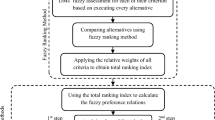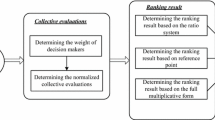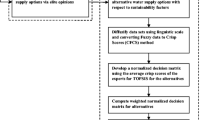Abstract
With the significant economic shift, water pollution treatment has gradually become a key problem which needs to be deeply investigated for the sustainable development of China. In the face of specific water pollution incidents, multiple alternatives are often required to work together in order to achieve better results. However, due to the limitation of resources, alternatives must be ranked to realize the effective allocation of resources, which means the more highly ranked ones should possess more disposable resources. Furthermore, the water pollution treatment process is a multi-stage and multi-objective process. In each stage, decision-makers may have different emphasis and thus have different preferences for the treatment alternatives. How to effectively aggregate decision-makers’ preferences in different stages into an overall preference so as to form a ranking of treatment alternatives under global constraints has turned into a problem worthy of discussion. Under such background, this paper proposes a multi-stage gray group decision-making method, where decision-makers use Group-G1 to rank and weight the criteria, and in this way, the weights of decision-makers and criteria in each stage could be determined. Considering the difference and deficiency of the cognitive level of decision-makers, this paper adopts the form of hesitant fuzzy linguistic term sets (HFITS) to express the evaluation information of decision-makers. And then, gray incidence analysis is selected to rank the alternatives. After ranking the alternatives in each stage, the multi-stage rankings will be aggregated into an overall ranking and the resource allocation is made according to the priorities of the alternatives. Finally, an example of water pollution treatment alternatives ranking based on a cyanobacterial bloom in Taihu Lake, China, is given to illustrate the proposed approach.
Similar content being viewed by others
References
Bartholomew DJ, Allerhand M, Deary IJ (2013) Measuring mental capacity: Thomson’s Bonds model and Spearman’s g-model compared. Intelligence 41(4):222–233
Brookes JD, Carey CC (2011) Resilience to blooms. Science 334(6052):46–47
Carey CC, Ibelings BW, Hoffmann EP, Hamilton DP, Brookes JD (2012) Eco-physiological adaptations that favour freshwater cyanobacteria in a changing climate. Water Res 46(5):1394–1407
Carmichael WW (2001) Health effects of toxin-producing cyanobacteria:“the CyanoHABs”. Hum Ecol Risk Assess Int J 7(5):1393–1407
Chen X, Zhao L, Özdemir MS, Liang H (2018) Mixed strategy to allocate resources with air pollution treatment in China: based on the analytic network process and large-group decision-making method. Environ Sci Pollut Res 25(17):16885–16899
Deng JL (1989) Introduction to grey system theory. J Grey Syst 1(1):1–24
Dong L, Shu W, Li X et al (2018) Quantitative evaluation and case studies of cleaner mining with multiple indexes considering uncertainty factors for phosphorus mines. J Clean Prod 183:319–334
Du JL, Liu Y, Forrest JYL (2019) An interactive group decision model for selecting treatment schemes for mitigating air pollution. Environ Sci Pollut Res 26:1–21
Ebenstein A (2012) The consequences of industrialization: evidence from water pollution and digestive cancers in China. Rev Econ Stat 94(1):186–201
Flores-Carrillo DA, Sánchez-Fernández LP, Sánchez-Pérez LA et al (2017) Soil moisture fuzzy estimation approach based on decision-making. Environ Model Softw 91:223–240
Fu F, Wang Q (2011) Removal of heavy metal ions from wastewaters: a review. J Environ Manag 92(3):407–418
Guo L (2007) Doing battle with the green monster of Taihu Lake. Science 317(5842):1166–1166
Guo Y, Guo X, Tian J et al (2015) Study of reciprocal effects between mandatory pollutant emissions reduction policy and structural change within the manufacturing sector in a Chinese coastal area. Environ Sci Technol 49(21):12840–12850
Le C, Zha Y, Li Y et al (2010) Eutrophication of lake waters in China: cost, causes, and control. Environ Manag 45(4):662–668
Liao H, Xu Z, Zeng XJ (2014) Distance and similarity measures for hesitant fuzzy linguistic term sets and their application in multi-criteria decision making. Inf Sci 271:125–142
Liu J, Yang W (2012) Water sustainability for China and beyond. Science 337(6095):649–650
Liu Y, Fan ZP, Zhang X (2016) A method for large group decision-making based on evaluation information provided by participators from multiple groups. Inf Fusion 29:132–141
Liu W, Zhang J, Jin M et al (2017) Key indices of the remanufacturing industry in China using a combined method of grey incidence analysis and grey clustering. J Clean Prod 168:1348–1357
Lu Y, Song S, Wang R et al (2015) Impacts of soil and water pollution on food safety and health risks in China. Environ Int 77:5–15
Micheli F (1999) Eutrophication, fisheries, and consumer-resource dynamics in marine pelagic ecosystems. Science 285(5432):1396–1398
Paerl HW, Huisman J (2008) Blooms like it hot. Science 320(5872):57–58
Qin B, Zhu G, Gao G et al (2010) A drinking water crisis in Lake Taihu, China: linkage to climatic variability and lake management. Environ Manag 45(1):105–112
Qin B, Li W, Zhu G, Zhang Y, Wu T, Gao G (2015) Cyanobacterial bloom management through integrated monitoring and forecasting in large shallow eutrophic Lake Taihu (China). J Hazard Mater 287:356–363
Qu J, Fan M (2010) The current state of water quality and technology development for water pollution control in China. Crit Rev Environ Sci Technol 40(6):519–560
Qu J, Meng X, You H (2016) Multi-stage ranking of emergency technology alternatives for water source pollution accidents using a fuzzy group decision making tool. J Hazard Mater 310:68–81
Qu J, Meng X, Jiang X et al (2019) Effective aggregation of expert opinions to inform environmental management: an integrated fuzzy group decision-making framework with application to cadmium-contaminated water treatment alternatives evaluation. J Clean Prod 209:834–845
Ren J, Lützen M (2017) Selection of sustainable alternative energy source for shipping: multi-criteria decision making under incomplete information. Renew Sust Energ Rev 74:1003–1019
Rodriguez RM, Martinez L, Herrera F (2011) Hesitant fuzzy linguistic term sets for decision making. IEEE Trans Fuzzy Syst 20(1):109–119
Shi S, Cao J, Feng L, Liang W, Zhang L (2014) Construction of a technique plan repository and evaluation system based on AHP group decision-making for emergency treatment and disposal in chemical pollution accidents. J Hazard Mater 276:200–206
Sun Y, Chen Z, Wu G et al (2016) Characteristics of water quality of municipal wastewater treatment plants in China: implications for resources utilization and management. J Clean Prod 131:1–9
Vonlanthen P, Bittner D, Hudson AG, Young KA, Müller R, Lundsgaard-Hansen B, Roy D, di Piazza S, Largiader CR, Seehausen O (2012) Eutrophication causes speciation reversal in whitefish adaptive radiations. Nature 482(7385):357–362
Wang Q, Yang Z (2016) Industrial water pollution, water environment treatment, and health risks in China. Environ Pollut 218:358–365
Xia J, Zhang YY, Zhan C et al (2011) Water quality management in China: the case of the Huai River Basin. Int J Water Res Dev 27(1):167–180
Xu Z (2005) Deviation measures of linguistic preference relations in group decision making. Omega 33:249–254
Yang C (2014) Market rebalancing of global production networks in the Post-Washington Consensus globalizing era: transformation of export-oriented development in China. Rev Int Polit Econ 21(1):130–156
Yang SQ, Liu PW (2010) Strategy of water pollution prevention in Taihu Lake and its effects analysis. J Great Lakes Res 36(1):150–158
Yang K, Ding Y, Zhu N et al (2018) Multi-criteria integrated evaluation of distributed energy system for community energy planning based on improved grey incidence approach: a case study in Tianjin. Appl Energy 229:352–363
Yu L, Lai KK (2011) A distance-based group decision-making methodology for multi-person multi-criteria emergency decision support. Decis Support Syst 51(2):307–315
Yuan F, Wei YD, Gao J et al (2019) Water crisis, environmental regulations and location dynamics of pollution-intensive industries in China: a study of the Taihu Lake watershed. J Clean Prod 216:311–322
Zhang XJ, Chen C, Ding JQ, Hou A, Li Y, Niu ZB, Su XY, Xu YJ, Laws EA (2010a) The 2007 water crisis in Wuxi, China: analysis of the origin. J Hazard Mater 182(1–3):130–135
Zhang J, Mauzerall DL, Zhu T, Liang S, Ezzati M, Remais JV (2010b) Environmental health in China: progress towards clean air and safe water. Lancet 375(9720):1110–1119
Zhang Y, Lin S, Qian X et al (2011) Temporal and spatial variability of chlorophyll a concentration in Lake Taihu using MODIS time-series data. Hydrobiologia 661(1):235–250
Zhou C, Hu D (2012) Research on inducement to accident/incident of civil aviation in southwest of China based on grey incidence analysis. Procedia Eng 45:942–949
Zhu J, Hipel KW (2012) Multiple stages grey target decision making method with incomplete weight based on multi-granularity linguistic label. Inf Sci 212:15–32
Zhu B, Xu Z (2013) Consistency measures for hesitant fuzzy linguistic preference relations. IEEE Trans Fuzzy Syst 22(1):35–45
Funding
This work is partially funded by the Humanities and Social Sciences of Education Ministry (18YJA630088), Soft Science Foundation of Jiangsu Province (BR2018007), and the Fundamental Research Funds for the Central Universities (2019JDZD06).
Author information
Authors and Affiliations
Corresponding author
Ethics declarations
Conflict of interest
The authors declare that they have no conflict of interest.
Additional information
Responsible editor: Baojing Gu
Publisher’s note
Springer Nature remains neutral with regard to jurisdictional claims in published maps and institutional affiliations.
Rights and permissions
About this article
Cite this article
Wang, J., Qian, W., Du, J. et al. Effective allocation of resources in water pollution treatment alternatives: a multi-stage gray group decision-making method based on hesitant fuzzy linguistic term sets. Environ Sci Pollut Res 27, 3173–3186 (2020). https://doi.org/10.1007/s11356-019-07265-6
Received:
Accepted:
Published:
Issue Date:
DOI: https://doi.org/10.1007/s11356-019-07265-6




